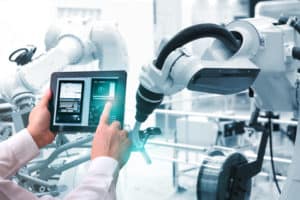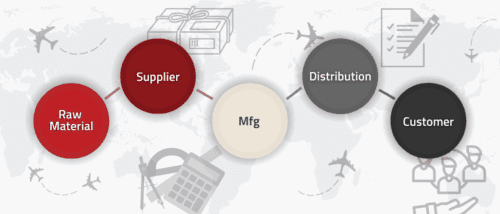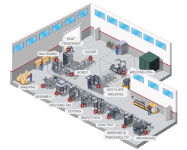How Industrial Automation Equipment is Helping to Bring Back Manufacturing to America
Leave a CommentIndustrial Automation is Powering and Innovating American Manufacturing
Advances in automation technology improve manufacturing techniques and power product innovation by enhancing how components are produced. Due to technology such as adaptive robotics, machine learning, and others, manufacturing processes are currently more refined and inexpensive than in the past. Investing in these technologies has enabled smaller factories to produce more new products and quickly adjust to changes in demand. These tools encourage innovation and facilitate the development of higher-quality products.
In recent years, new technological advancements in optics, wireless communications, and sensors have enabled automated systems to graduate from simple repetitive tasks to undertaking increasingly complex processes. There is a common misconception that adopting technology like this results in a disadvantage for American workers; however, research and statistics offer a different story.
The Economic Advantages of American Automation
Investing in automated manufacturing technology offers several economic advantages aside from innovation and job growth. Most importantly, automation can enhance productivity. It has been predicted that automation can raise global productivity by 0.8% to 1.4%, which results in higher output, higher margins for businesses, higher wages for workers, and lower prices for consumers.
This productivity growth especially helped during the pandemic. Despite lockdowns and reduced workforces, automated equipment helped to raise U.S. productivity by nearly 4% since 2019. Companies are expected to continue investing in newer technologies through 2024, which will further boost productivity and enhance overall living standards.
The Boom in Robotic Automation & Its Benefits for Manufacturers
In recent years, an ever-increasing number of manufacturers have been adopting robotic automation solutions. Reuters reports that in 2021, North American companies invested over $2 billion in robotic manufacturing solutions, a 28% increase from the previous year. This increase can be credited to the many benefits that robotic automation provides, such as process optimization and increased supply line resilience.
While there is currently a record demand for products, supply chain challenges are increasing production difficulties. Robots mitigate many of these issues for manufacturing companies, including a lack of labor resources. Robotic automation can be applied to any industry to eliminate errors caused by highly repetitive work, as well as improve safety, increase throughput speed, and improve processes. Overall, industrial robots have helped manufacturing companies in four key ways:
- Increasing manufacturing company resilience
- Optimizing processes to increase efficiency
- Help manufacturing companies keep up with record product demand despite supply chain challenges
- Alleviate strain on manufacturing companies due to labor shortages, as robots can fill positions that are challenging for human workers to fill
Manufacturers are seeing the undeniable benefits of robotic automation, and experts predict an increase in robots in the workplace. This is currently being seen across many industries. For example, while the automotive industry has historically been the largest user of robotics, the electronics industry is currently the world leader in robotics acquisition, with more industries following suit.
Industrial Automation Doesn’t Eliminate Jobs or Hinder Job Growth
A commonly expressed fear of industrial automation is that it would eliminate jobs. However, in actuality, these advancements are creating new types of jobs. The World Economic Forum projected that by 2022, automation would be responsible for 133 million new jobs despite a 75 million loss. This can be seen historically as well, when the invention of computers displaced secretaries and typists but created a demand for IT professionals and technicians.
Robots are often involved in misconceptions about automation; however, the facts show that robots actually create significantly more jobs than they displace. Robotics upskill workers, allowing them to obtain additional capabilities in automation. The reliable productivity robotic solutions provide has even enabled many manufacturers to expand and hire more workers.
How to Upskill Workers
A barrier to adopting industrial automation solutions is that workers might not have the necessary skillset. This is where an automation integrator can help. An integrator incorporates a robot into a manufacturing environment and ensures workers understand how to operate it. Automation integrators, such as AMD, provide a manufacturer with all the tools they need to be successful and self-sufficient. This can involve training the manufacturer on operating automated equipment, being available to provide tech support, and more.
Industrial Automation Costs
While automation systems might seem prohibitively costly upfront, particularly to small or mid-sized manufacturers, the undeniable ROI they provide ensures they quickly pay for themselves. Some of the most significant financial benefits of automation systems include:
- Improved product quality
- Increased production capacity
- Improved efficiency
- Safer working conditions
When considered in the long term, adopting automation solutions can significantly improve the financial success of businesses of all sizes.
AMD is Helping American Manufacturers, Like You
While in the past there have been numerous misconceptions about the effects of automated manufacturing solutions, this technology is rapidly being adopted by a range of industries, with demonstrated positive results. AMD helps manufacturers of all sizes successfully automate their facilities and become self-sufficient. We work closely with our customers to craft solutions that meet their every need and goal.
At AMD, we use CNC machining to produce our automation system parts in-house, delivering high-quality solutions every time. Some of the industries we help automate include automotive, appliances, consumer goods, and much more. To learn more about the solutions we offer, contact us. You can get started on a personalized system today by requesting a quote.
What Is Supply Chain Resilience?
1 CommentThe COVID-19 pandemic was an eye-opener for many businesses, revealing their supply chains’ limits and vulnerabilities. Supply chain resilience is the capacity of a supply chain to adapt to unforeseen events. Companies with resilient supply chains not only have the capability to adjust rapidly and continue operations in the face of supply chain challenges, but they are proactive, remaining vigilant and utilizing real-time data to look for potential disruptions or changes to demand and make quick, informed business decisions.
Optimal supply chain resilience means planning ahead and preparing for breaks in the supply chain, enabling organizations to return more quickly to normal production. Read on to learn more about supply chain resilience, how you can strengthen your supply chain for reliable production, and the benefits of working with local partners.
How to Improve Your Supply Chain
Any number of factors can cause your supply chain to break down. In addition to epidemics, some supply chain disruption examples include:
- Extreme weather conditions or geological disasters
- War and incursions
- Cyber attacks
- Labor shortages or disputes
- Transportation or gas shortages
- Component shortages
Given the rise in global sourcing and manufacturing, keep in mind that another country’s circumstances can greatly impact your business in the U.S.
One of the most crucial components of supply chain resilience is contingency planning or preparing to the best of your ability for disruptions. However, merely coming up with a strategy isn’t enough. You must enact your plan and ensure that you review your networks and inventory regularly. This update exercise should entail a business study of your most important suppliers based on SKUs.
Evaluate your relationships with all of your present suppliers, and then develop a list of viable alternates, giving you an actionable risk management strategy outlining what to do to maintain production if any of those linkages fail. These alternatives may include public and private entities, comparing and diversifying your procurement options to consider domestic, near-shore, and offshore sources. Ultimately, being able to detect and quickly react to supply chain changes requires data-driven, end-to-end supply chain management.
Building a Resilient Supply Chain
While it isn’t possible to account for every situation, supply chain mapping allows you to prepare for the most likely scenarios and determine their potential impacts on your business. It may take a lot of work to break down a distribution network and track key suppliers, but when (not if) there is an interruption, the preparation will save you from downtime and lost revenue.
Creating a supply chain map can be as easy as downloading a free template, or you can utilize computer software programs to examine links in your supply chain. This will require you to not only understand your tier 1 and 2 suppliers and manufacturers, but also to question and research where those businesses source their own products and materials to determine their infrastructure systems.
Mapping is only the first step, however. There are five basic steps to achieving supply chain resilience, and the remaining four are:
- Initial assessment. Once you have completed your research, truly analyze the capacities and capabilities of the businesses in your supply chain through open-source data to pinpoint possible weaknesses.
- Outreach. This stage involves meeting with specific stakeholders and evaluating the results from steps 1 and 2, building cooperative partnerships to improve supply chain resilience and transparency.
- Plan development and implementation. At this stage, you’ll create an actionable plan based on supply chain logistics and other information you’ve gathered and utilize preparedness activities to implement it. Then, in a crisis, you are ready to put your strategy into practice.
- Plan review and revisions. This step is ongoing, requiring you to update and review supply chain data over time, make necessary revisions to the analysis, and keep stakeholders involved for continued supply chain resilience.
AMD: A Reliable Resource in Your Industry Supply Chain
Advanced Manufacturing Development, Inc. focuses on self-sufficiency, stability, and supply chain resilience. Our company experienced vertical growth when we started doing our own CNC machining rather than relying on outside vendors to supply components for our industrial automation solutions. We use our technical expertise to design and create products based on your requirements and industrial standards as the sector continues to experience a need for the rapid manufacture of innovative, complex parts.
Using a local supplier for your machinery and assembly line needs offers you several advantages, such as minimal risk for supply chain interruptions, increased service options, a more extensive inventory, and economical pricing while maintaining a high degree of quality. AMD offers products and services like robotic cells, assembly line and custom automation equipment, test systems, welding, leak detection, branding, and traceability to support local businesses and improve operations.
If your existing supplier cannot meet your demand or quality criteria for services or machinery, let AMD customize a manufacturing solution for your business. Contact us for more information or request a quote today.
Why Robotic Cells Are the Future of Manufacturing
1 Comment
Unlike human workers or traditional machines, robotic cells are autonomous and can consistently perform complex tasks over night, weekend, and holiday shifts without the presence of a controller. Examples of tasks include detecting leakage, assembly, welding, testing, and transferring products to their next station. The lack of human intervention streamlines production efficiency. Read on to learn why robotic cells are the future of manufacturing.
Assembly Line Efficiency: Traditional Manufacturing vs. Robotic Cells
Early automobile manufacturers such as Ford used a classic assembly line to manufacture cars. Traditional manufacturing comprised several steps performed by different workers to come up with a single product. The end products were often large and complex, but despite their complexity, they were all identical. The process relied on balanced timing from station to station, but relying on human workers led to increased wait times as workers down the line waited for their colleagues in previous stations to finish their part. This waiting resulted in labor-intensive, inefficient production.
As technology has advanced and demand for product variation increased, manufacturers have attempted to adapt their assembly lines. To accommodate differences between products, some products need more time to manufacture than others. However, this leads to decreased productivity and increased waiting time. Manufacturers—and their customers—require a more innovative solution.
Automated manufacturing is increasingly replacing traditional manufacturing. An automated assembly system still utilizes the sequential process of classic manufacturing, but automated lines have more machines and fewer human workers. This feature has greatly reduced human error, added the capability of accommodating product variation, lowered long-term production costs, and made the workplace safer.
Robotic cells can be used to handle different tasks, such as:
- Pick and place
- Deburring
- Sorting
- Assembly
- CNC machine tending
- Painting
- Finishing and polishing
- Welding
Robotic Cells Have a Fast ROI
Although robotic cells require a significant initial cost, they offer a quick return on investment, which is a key factor when working on a tight budget. Companies can receive a full ROI within as little as a year when working with robotic cells. The cost of hiring and retaining employees to work on different parts of the manufacturing process can accrue over the years. Robotic cells significantly lower the cost of human labor, leading to increased productivity and profits. Instead, companies can hire human employees for more complex and fulfilling roles, such as engineering and programming.
Enhanced Safety in a Robotic Cell
Another great advantage of robotic cells is the safety aspect. Robotic cells have scanners, fencing, emergency stops, light curtains, and additional safeguards to ensure employee safety while working close to these machines. Robotic cells can also easily handle tasks that would otherwise be high-risk to workers, such as processes that use toxic chemicals, sharp objects, and heavy machinery.
Flexibility of Robotic Cells
Today, customers want to have personalized products. For example, when you buy a car you want to be able to choose the exterior and interior colors, sound system, etc. Conversely, traditional fixed automation is not flexible enough to handle personalized production. Robotic cells, however, offer much more flexibility when it comes to personalizing the product to a customer’s liking as well as all the benefits mentioned above. The robot’s inherent flexibility in handling a wide variety of products is also very convenient when many variations need to be handled by the same assembly line.
Needless to say, new manufacturing technologies are programmable to fit the expertise or the needs of your personnel and assembly line.
Your Partner for Your Robotic Work Cell Needs
The advantages of robotic cells far outweigh those of traditional manufacturing. At AMD, we are experts in designing and manufacturing custom robotic cells for different applications based on our customers’ unique needs. If a robotic work cell doesn’t fit your process, AMD provides manual, semi-automated, and fully-automated machines. With the help of our experienced team of robotic specialists, you can select the solution that works best for you. Contact us today or request a quote to get started on your solution.



